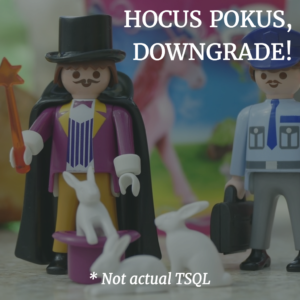Erik Darling and Kendra Little Talk AI, Databases, and SQL Server 2025
Erik Darling joins me on the Dear SQL DBA Podcast to chat about AI tools, why they work better for Python and PowerShell than SQL, and what’s …
Read MoreI got a great question about Edition downgrades recently.
I have discovered a tranche of potential money saving by replacing SQL Server Enterprise Edition with SQL Server Developer Edition where appropriate. All of the checks have been made - i.e. the Servers are truly Development servers, with nothing Production going anywhere near (either data or people).
What’s the simplest way of changing a SQL Server in this way? It looks like an uninstall / re-install but there’s an awful lot of objects on that Server - Databases, Security, Linked Servers, SSIS, Triggers, so a lot of work. Some people on the Internet suggest copying the system databases before re-installing to the same patch level then copying the previous system databases back in.
Hoping to pull off the Tablecloth trick
Whee! It’s always so much fun when you can save a lot of licensing costs.
When an environment is being used for development, it can be licensed with free Developer Edition (even if you do user acceptance testing in it).
And Developer Edition has all the features of Enterprise Edition. Pretty great deal, eh?

If you’re using Evaluation Edition, you can often change to other editions quite easily.
But you can’t easily downgrade your editions, and there’s also limitations on changing editions when you’re using a cluster. Microsoft has a list of Supported Version and Edition Upgrades here.
Basically there’s no supported path to use the built-in tools to quickly change from Enterprise to Developer Edition.
“Unsupported” isn’t always terrible. It doesn’t mean “illegal”. It just means that Microsoft isn’t going to help you if something goes wrong because of what you did.
Technically, running the “DBCC PAGE” command is unsupported, and running it can even sometimes cause stack dumps. I still blog about it and run it sometimes, I’m just careful.
In this case, doing an unsupported downgrade might be just fine. I wouldn’t like managing the environment afterward because it’s such a significant unsupported action – if I choose to take a system-database copying shortcut, am I going to be haunted by that for a long while afterward when anything goes wrong in the environment?
I’ve been burned by things like that over the years, so I’m a bit careful.

And then you start hitting issues where you deploy to production, and it doesn’t work there, but it worked fine in Dev. Because the dev environment doesn’t resemble production much anymore.
For this reason, I’m a big fan of being able to rebuild dev from scratch periodically:
It’s a huge pain to make a big modification in-place on an environment. Even dev environments, because things don’t always work in dev and sometimes it’s fine: so if you change the environment in place, afterward you have a hard time figuring out if your change broke it, or if it was just already broken.
It’s so much easier when you have the “before” around to compare to the “after”, and you’re doing a switcharoo rather than changing what’s in place.
This is one of the things that’s fantastic about virtualization - being able to set up a new environment and keep the old around on slow hardware for a while. When things don’t work, you go look at the old one to see what you missed.
So I would want to:
My way of approaching this is definitely not the simplest or the fastest. It’s just the one that results in an environment I’m happier living with.
What about you, Internet Reader? Have you used shortcuts for downgrading editions and had good experiences? Bad experiences?
Copyright (c) 2025, Catalyze SQL, LLC; all rights reserved. Opinions expressed on this site are solely those of Kendra Little of Catalyze SQL, LLC. Content policy: Short excerpts of blog posts (3 sentences) may be republished, but longer excerpts and artwork cannot be shared without explicit permission.